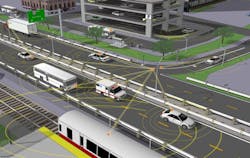On July 17, Comcast filed its comments to the FCC to eliminate net neutrality. One of its arguments was that autonomous vehicles would require the prioritization of instantaneous data transmission to operate on the road. Here’s the pertinent text:
“At the same time, the Commission also should bear in mind that a more flexible approach to prioritization may be warranted and may be beneficial to the public…for autonomous vehicles that may require instantaneous data transmission; black letter prohibitions on paid prioritization may actually stifle innovation instead of encouraging it.”
Not only is this statement nonsense, it’s is setting a bad precedent for the Internet of Things (IoT). If the trends of Industry 4.0 have taught the rest of the world anything, it’s that open protocols, standards, and programming language lead to faster results. Germany has been able to push Industry 4.0 at an extremely fast pace, and that methodology should be applied to net neutrality. If we want to live in a connected industrial world, net neutrality needs to survive.
First, let us discuss why the claim from Comcast is ridiculous. Net neutrality, for those unfamiliar, is the principle that all internet service providers treat all internet content the same. They are not allowed to give any specific content preferential treatment regardless of the subject matter or provider of said content. This principle was set in place in the 2015 ruling from the FCC that declared broadband service as a public utility under Title II Order of the 1934 Communications Act. The fact that net neutrality exists allows people to use the internet equally. Consumers, for example, can stream content equally regardless of the service. If net neutrality were to be abolished, then Netflix could pay more than Amazon does for streaming rights and users of Amazon’s Prime service would be at a disadvantage.
The reason why the claim made by Comcast makes no sense is because of the method autonomous vehicles will use to communicate with each other in the future. As explained by The Verge, communication between self-driving cars will be occurring on the unlicensed spectrum called the Dedicated Short Range Communications (DSRC) band. The FCC has already designated this spectrum in the 5.9 GHz band specifically for the use of connected vehicles also known as vehicle-to-everything (V2X) applications. These include vehicle-to-vehicle, vehicle-to-infrastructure, and vehicle-to-pedestrian.
“Wireless carriers have been trying to snatch back that 5.9 GHz spectrum to use it for other purposes that they can make money on, and if that happens, it will be a real problem for automated vehicles,” said Sam Abuelsamid, senior analyst at Navigant Research, in the article by The Verge. Comcast claims it’s referring to LTE-Vehicular communications and not DSRC, even though LTE-Vehicular has no practical applications to date.
This behavior by Comcast sets a bad precedent for IoT manufacturers. Obviously, net neutrality does not affect the data captured or transmitted internally by a company. Any edge device with sensors, wireless communications between mobile devices and the company’s network—or data transmission between IoT connected devices and a central server—will depend on the internal configuration of a company. These communications can be maximized for optimal performance by using the latest wireless routers, antennas, and Ethernet cables.
The problem of net neutrality comes into play when discussing cloud services and remote access. More companies are realizing that the massive amounts of data collected from sensors and IoT systems need to be analyzed, and the internal computing services are not enough. Cloud analytics is becoming an important component of the IoT landscape. Remote access is also a major benefit of IoT connected services. Users that can access data remotely, schedule production services, or provide remote control maintenance are one of the highlights of the IoT world.
These benefits would be hampered by eliminating net neutrality. If a company had to pay more to gain higher bandwidth capacity to their data, then only the big-name companies would be able to compete without restrictions. Middle- to small-level companies would struggle to successfully run their IoT systems because they would not be able to afford faster internet access. We should fight for net neutrality so that the IoT industry can be accessible for all and continue to grow in all areas—not just in the companies that can afford it.


